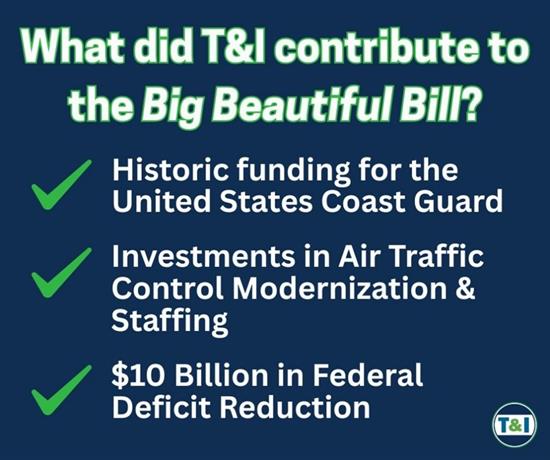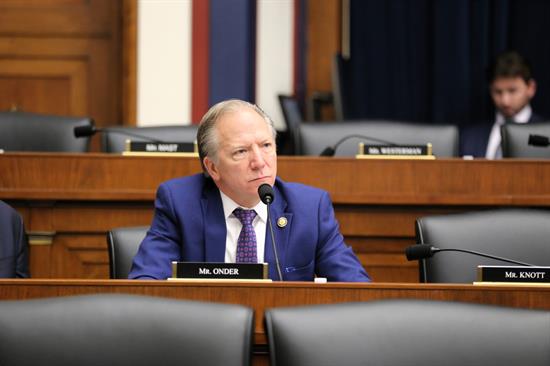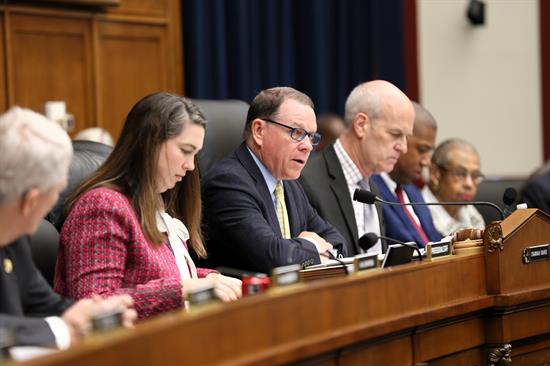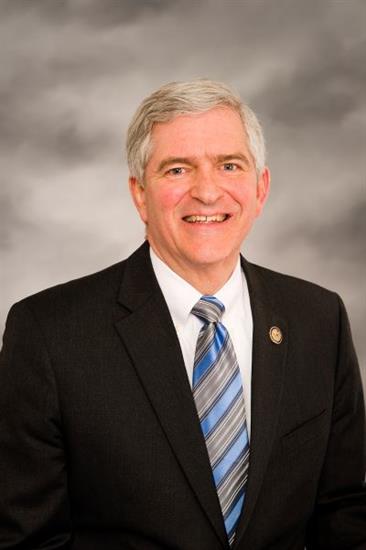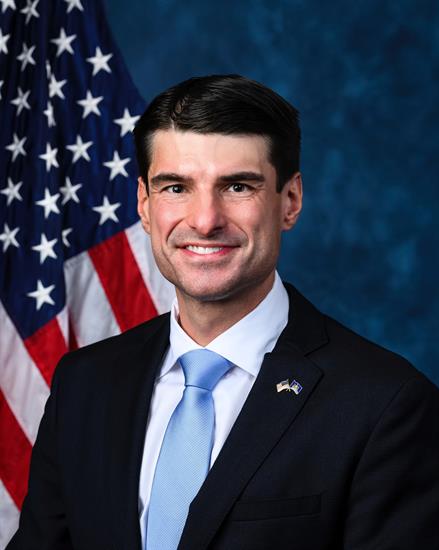
| THE RUNWAY: MAY RECAP |
| In this Issue: | |||||
|
| ONE BIG BEAUTIFUL BILL ACT PASSES THE HOUSE | ||
H.R. 1, the One Big Beautiful Bill Act, which advances President Trump’s America First Agenda and includes crucial elements from the Transportation and Infrastructure Committee, passed the House of Representatives on May 22nd. T&I’s portion of the bill provides critical funding to the United States Coast Guard, needed investments in air traffic control modernization and staffing, and cuts to wasteful spending. These key provisions have garnered broad support from transportation industry and labor stakeholders. “The bill includes provisions from the Transportation and Infrastructure Committee to provide historic investments in the United States Coast Guard to strengthen our national and border security, as well as funding to modernize the nation’s outdated air traffic control system,” said Chairman Graves. “We coupled these investments with money-saving measures like cutting wasteful Green New Deal spending, ensuring that electric vehicles begin contributing to the Highway Trust Fund, and more.” Read more about the passage of the One Big Beautiful Bill Act here. |
||
|
|
||
|
|
||
| INFRASTRUCTURE WEEK | ||
|
|
||
| COMMITTEE ACTIVITY | ||
|
The Railroads, Pipelines, and Hazardous Materials Subcommittee held a hearing to discuss ways to improve the efficiency and effectiveness of federal rail assistance. During the hearing, Members examined the opportunities and challenges that grant applicants encounter in utilizing Federal Railroad Administration (FRA) and other Department of Transportation (DOT) rail discretionary grant programs and the potential for reform in the upcoming surface transportation reauthorization bill. At the beginning of the hearing, Subcommittee Chairman Daniel Webster (R-FL) said, “Most of us are familiar with the unfortunate and unnecessary reputation of our country for building and repairing infrastructure: it takes too long and costs too much.” Witnesses noted that lengthy processes and bureaucratic red tape delay infrastructure projects, often adding years to their completion and significantly increased costs. Both Members and witnesses agreed on the need to streamline initiatives to ensure projects are completed more efficiently and on time. Read more about the Subcommittee hearing here. Cleaning Up the Past, Building the Future: The Brownfields Program The Water Resources and Environment Subcommittee held a hearing to discuss the Environmental Protection Agency’s (EPA) Brownfields program and hear local and national perspectives on the program. The Brownfields program helps redevelop abandoned or underused contaminated properties. In his opening statement, Subcommittee Chairman Mike Collins (R-GA) stated that “EPA has estimated that there are more than 450,000 brownfield sites across the United States. Their redevelopment and reuse can help increase local tax bases, create jobs, and encourage additional development.” Members and witnesses discussed the program and provided input on commonsense liability relief for those seeking to improve degraded sites. The EPA program supports communities by assessing and evaluating contamination at these sites and providing funding to help clean up and promote their redevelopment. To underscore the challenges and opportunities that brownfield redevelopment presents, Rep. Bob Onder (R-MO) highlighted that in his district, several potentially valuable brownfield sites remain vacant. One of the witnesses said it’s most likely due to contamination concerns and the broader housing affordability crisis. Read more about the Subcommittee hearing here.
Member Day Dozens of House Members testified at a hearing about T&I priorities that are important to their individual districts. These priorities reflected the diverse needs and challenges facing communities across the country. Members spoke about investing in infrastructure, modernizing air traffic control technology, public transit, and more. Their testimony underscored the wide regional differences in infrastructure needs as T&I plans for a surface transportation reauthorization bill. Read more about the full Committee hearing here. FAA Reauthorization Act of 2024: An Update on Implementation One Year Later On May 16th, T&I commemorated the one-year anniversary of the enactment of the FAA Reauthorization Act of 2024, a comprehensive, bipartisan bill to reauthorize the FAA, as well as aviation infrastructure and safety programs for the next five years. The day before the anniversary, the full Committee held a hearing to hear updates on the status of various provisions of the law. Witnesses noted challenges such as modernizing the national airspace system and enhancing the aviation workforce. In his opening statement, Chairman Graves highlighted the reconciliation package passed by the House, which appropriates $12.5 billion to the FAA for air traffic control modernization. “This $12.5 billion investment will provide a significant down payment on the Administration’s plan to overhaul and modernize the ATC system, and I look forward to working with them in that effort,” said Chairman Graves. Read more about the full Committee hearing here.
Federal Courthouse Design and Construction: Examining the Costs to the Taxpayer Following recent changes to the United States Courts official Design Guide, which dictates the basic requirements for new courthouses, the Subcommittee on Economic Development, Public Buildings, and Emergency Management held a hearing to evaluate the 2021 Design Guide, the most recently revised version. In 2024, the Government Accountability Office (GAO) released a report that looked at six recently constructed courthouses that had been built using the previous 2007 Design Guide. (No new courthouses have been built yet using the 2021 Design Guide.) According to the report, if the 2021 Design Guide had been used for these six courthouses, it would have increased the size by almost six percent and the construction costs by almost 12 percent. Members had the opportunity to examine how the changes have impacted the costs associated with designing, constructing, and operating federal courthouses. Subcommittee Chairman Scott Perry (R-PA) said, “The United States Courts are asking Congress, and more importantly our bosses – the American taxpayers – to spend hundreds of millions of dollars on new courthouse construction despite decades of oversight that has found that Design Guides have enabled the construction of courthouses that are too large and too costly.” Building on concerns about courthouse construction costs, Rep. Tom Barrett (R-MI) echoed the need for fiscal restraint, turning the focus to the issue of rising building costs: “The escalation dramatically of building costs over time has made it such that we have to be far more mindful about the capital expense of things. Everything from building materials, to labor, to siting approval, to engineering, design, all of that has become far more expensive over time, and it ends up coming out of the appropriations that come from Congress.” Read more about the Subcommittee hearing here. |
||
|
|
||
| MEMBERS SPOTLIGHT | ||
Since 2011, Rep. Daniel Webster (R-FL) has represented his Florida congressional district. Prior to coming to Congress, he served as both Speaker of the House and Senate Majority Leader in the Florida legislature. On T&I, he has previously served as Chairman of the Coast Guard and Maritime Transportation Subcommittee, and he now serves as the Chairman of the Railroads, Pipelines, and Hazardous Materials Subcommittee. This month, the Subcommittee held a hearing to explore both the opportunities and obstacles grant applicants face when accessing Federal Railroad Administration (FRA) and other Department of Transportation (DOT) rail discretionary grant programs. The hearing’s discussion also addressed potential reforms in the upcoming surface transportation reauthorization bill. During the hearing, Rep. Webster questioned witnesses about the factors driving up project costs and the challenges applicants encounter. Witnesses pointed to prolonged processes and bureaucratic red tape as major contributors to delays, often adding years to infrastructure projects and significantly inflating costs. There was broad agreement among Members and witnesses on the need to streamline procedures to help ensure projects are completed more efficiently and on schedule.
Rep. Rob Bresnahan, Jr. (R-PA), a successful small businessman in the construction and other industries, is a first-term congressman representing the 8th district of Pennsylvania. In addition to the Transportation and Infrastructure Committee, he serves on the Committee on Small Business and the Committee on Agriculture. Recently, he co-sponsored H. Res. 364, which calls upon local communities to support organizations that provide resources and aid to Gold Shield Families in their time of need. Rep. Bresnahan said, “I am incredibly proud to support H. Res. 364, which honors the families of fallen first responders — our Gold Shield Families. Their sacrifice, strength, and resilience must never be forgotten. This resolution sends a clear message: we see you, we honor you, and we stand with you.” |
||
|
IN THE NEWS |
||
|
Chairman Graves for The Washington Examiner: One Big Beautiful Bill Act provides a flight path for a modern air traffic control system Chairman Graves for Passenger Transport: Making Transit Work for All Americans Rep. Fong for The Washington Times: Without extending the Trump tax cuts, our American dream is at risk Rep. Begich for The Washington Examiner: Our skies must be the safest in the world. It starts with upgrading air traffic control Rep. Knott for the Carolina Journal: Congress can unleash NC’s economy |
|
